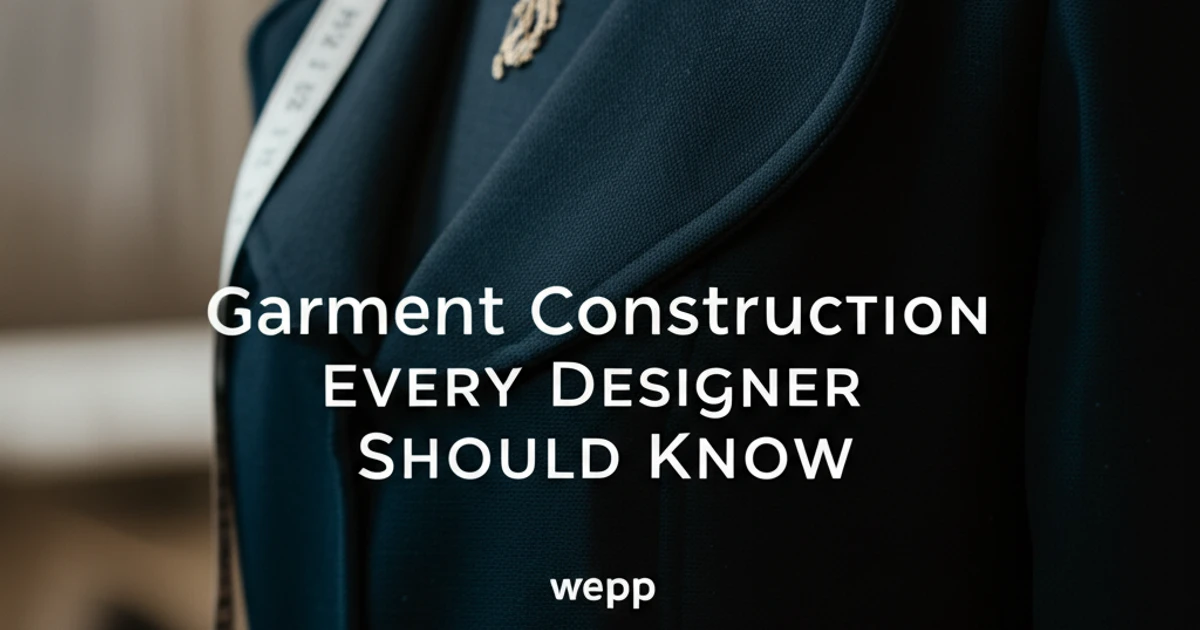Hello, future fashion legends and seasoned Garment Construction creatives!
Have you ever gazed at a couture gown or a beautifully tailored jacket and wondered about the magic that brings it to life? It’s not just the design, the fabric, or the vision – it’s the mastery of *garment construction methods*. As a designer, your sketchbook is your dream space, but the techniques you employ to build your garments are the bridge between that dream and a tangible, wearable reality. This isn’t just about sewing; it’s about engineering, problem-solving, and a deep respect for the craft.
Early in my career, I vividly remember the frustration of seeing a beautifully conceived design fall flat because my construction skills weren’t up to par. A stunning silk georgette draped like a potato sack because I chose the wrong seam, or a sharp tailored collar turned into a sad, floppy mess. It was a wake-up call that truly transformed my approach to design. That’s why I’m so passionate about sharing these essential *fashion construction techniques* with you. Whether you’re a *fashion student* just starting out, an *aspiring designer* with big dreams, or a seasoned pro looking to refine your craft, understanding these fundamentals is your secret weapon. Think of this as your essential *designer guide* to making your visions not just seen, but *felt* – with quality, durability, and a professional finish that speaks volumes.
Why Do We Even Talk About Seams? The Unsung Heroes of Durability and Drape.
You might think a seam is just a seam, right? Two pieces of fabric stitched together. But oh, how wrong that assumption can be! The choice of seam can make or break the drape, strength, and overall longevity of your garment. It’s a fundamental *garment construction method* that often gets overlooked in the initial creative rush.
Take the humble Plain Seam – it’s the most common, but often needs a finish like overlocking or zigzag stitching to prevent fraying. Perfect for areas with low stress or where you want a minimal bulk. Then there’s the elegant French Seam, a personal favorite for sheer fabrics like chiffon or delicate silk. It encases the raw edges completely, creating a clean, professional finish that whispers luxury. Imagine a delicate blouse where not a single raw edge is visible – that’s the magic of a French seam. For robust, utilitarian pieces like jeans or workwear, the Flat-Felled Seam is your sturdy companion. It’s incredibly strong, durable, and creates a neat, flat ridge that stands up to heavy wear. Choosing the right seam isn’t just a technical decision; it’s a design decision that impacts the garment’s narrative.
Beyond the Basic Stitch: What’s the Secret to a Truly Professional Finish?
Once your seams are in place, what separates a good garment from a truly exceptional one? Often, it’s the internal finish. Imagine opening a beautifully wrapped gift, only to find the contents haphazardly shoved inside. The same applies to clothing. Meticulous interior finishing is a hallmark of quality and a non-negotiable *garment construction method* for any designer aiming for excellence.
Techniques like Overcasting (using a serger or zigzag stitch) are essential for preventing raw edges from fraying, particularly in woven fabrics. For a more refined touch, consider Bound Seams or the luxurious Hong Kong Finish. These involve encasing the raw edge in a strip of bias fabric, creating a beautiful, clean line that’s visually appealing and incredibly durable. I once had a client who literally turned her jacket inside out to admire the finish, saying, “The inside is as beautiful as the outside!” That’s the power of these details. They show a garment that has been thoughtfully engineered, not just assembled.
How Do We Give Garments Structure and Shape? The Magic of Interfacings and Underlinings.
Have you ever wondered how a collar stays crisp, a waistband holds its shape, or a delicate fabric gains just the right amount of body? The answer lies in the strategic use of interfacings and underlinings. These internal support systems are unsung heroes in the world of *fashion construction techniques*, providing the backbone that allows your designs to truly shine.
Interfacing comes in various weights and types – fusible (iron-on) or sew-in. It’s applied to specific areas like collars, cuffs, facings, and plackets to provide stiffness, support, and prevent stretching. Think of it as the skeletal system of your garment. A perfectly interfaced collar will stand proud, framing the face beautifully, while a limp one will detract from the entire design. Underlining, on the other hand, is a full layer of fabric sewn directly to each main pattern piece before assembly. It can add opacity to sheer fabrics, stability to delicate ones, or even reinforce a garment against wear. For instance, underlining a lace dress with a silk organza can give it incredible structure and luxury without adding bulk, allowing the lace to truly sing. Mastering these elements transforms a piece of cloth into a structured, intentional design.
Zippers, Buttons, and Beyond: What Makes a Garment Function Flawlessly?
The functionality of a garment is just as crucial as its aesthetics. Imagine a stunning dress with a zipper that snags, or a tailored coat with buttons that constantly pop off. These seemingly small details, when poorly executed, can ruin the entire experience of wearing your design. Precision in applying closures is a core *garment construction method* that every designer must master.
From the almost invisible whisper of an Invisible Zipper to the robust statement of an exposed metal one, each zipper type serves a distinct purpose. Learning to insert them smoothly and cleanly, ensuring they lie flat without puckering, is a critical skill. Then there are buttonholes – machine-made for efficiency, or hand-sewn for a couture touch. The placement, size, and neatness of your buttonholes can elevate or diminish a garment’s perceived quality. And let’s not forget snaps, hooks and eyes, and various ties. Each closure requires careful consideration of the garment’s design, fabric, and intended use. Early in my journey, I spent hours perfecting invisible zippers; the satisfaction of that first flawlessly integrated zipper was immense, a testament to patience and practice.
The Devil’s in the Details: How Do We Elevate a Design from Good to Grand?
Ultimately, what truly sets a designer apart is their attention to the exquisite details. It’s the thoughtful execution of elements like pockets, cuffs, and waistbands that transform a garment from merely ‘made’ to truly ‘crafted.’ These are the moments where your *fashion construction techniques* truly get to shine, demonstrating your mastery and dedication.
Consider the precision required for a perfectly matched patch pocket, the crisp fold of a well-executed cuff, or the smooth curve of a tailored waistband. These aren’t just decorative elements; they are integral parts of the garment’s structure and aesthetic. A well-placed welt pocket can add sophistication to a jacket, while a perfectly proportioned collar can frame a face exquisitely. These elements demand not only technical skill but also an artistic eye for proportion and balance. They speak to the garment’s narrative – telling a story of thoughtful design, meticulous execution, and a deep understanding of how form and function intertwine. These details are your signature, the mark of a designer who cares deeply about their craft.
Your Journey to Construction Mastery
Embarking on the path to mastering *garment construction methods* is an exciting and deeply rewarding journey. It’s about empowering yourself to bring your wildest design dreams to life, transforming flat fabric into three-dimensional art. Remember, every stitch is a decision, every seam a statement, and every detail an opportunity to express your passion for fashion.
Don’t be afraid to experiment, to make mistakes, and to constantly refine your *fashion construction techniques*. The journey from a novice *fashion student* to an accomplished designer is paved with practice, patience, and a relentless pursuit of quality. Invest time in learning these essential skills, for they are the foundation upon which your most stunning creations will stand. Your designs deserve to be built with integrity and skill. So, grab your needles, thread, and enthusiasm – and let’s build some magic!


